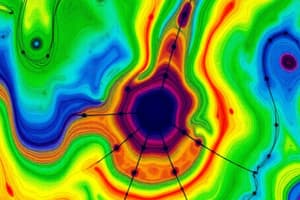Podcast
Questions and Answers
What is the Resistivity Method used for?
What is the Resistivity Method used for?
- Measuring current flow
- Measuring electrical potential
- Measuring electromagnetic fields
- Studying earth resistivity (correct)
What is Induced Polarization (IP)?
What is Induced Polarization (IP)?
- A passive method that measures current flow
- An active method that measures transient variations in potential (correct)
- A method that measures the presence and quality of pore fluids
- A method that measures electromagnetic fields
What phenomena can be measured using electrical methods?
What phenomena can be measured using electrical methods?
- Current flow and electrical potential (correct)
- Gravity and magnetism
- Temperature and pressure
- Chemical composition and crystal structure
What is the advantage of Wenner array over Schlumberger array?
What is the advantage of Wenner array over Schlumberger array?
What is the disadvantage of Wenner array?
What is the disadvantage of Wenner array?
What is the limitation of DC soundings?
What is the limitation of DC soundings?
What is the empirical relationship between current and voltage defined by Georg Ohm in 1827?
What is the empirical relationship between current and voltage defined by Georg Ohm in 1827?
What is the constant of proportionality in Ohm's law called?
What is the constant of proportionality in Ohm's law called?
What is resistivity and what is the symbol used to indicate it?
What is resistivity and what is the symbol used to indicate it?
What controls the measured resistivities of Earth materials?
What controls the measured resistivities of Earth materials?
What can lead to low resistivities in crystalline rock?
What can lead to low resistivities in crystalline rock?
What is an equipotential line?
What is an equipotential line?
What is current density?
What is current density?
What is the formula for electric potential at distance away from current source on surface?
What is the formula for electric potential at distance away from current source on surface?
What are the most commonly used electrodes for DC resistivity surveys?
What are the most commonly used electrodes for DC resistivity surveys?
What is the simplest geometry of electrode placement for resistivity sounding surveys?
What is the simplest geometry of electrode placement for resistivity sounding surveys?
What is the advantage of using a Schlumberger survey over a Wenner survey?
What is the advantage of using a Schlumberger survey over a Wenner survey?
What is the equation for computing the apparent resistivity in a Wenner survey?
What is the equation for computing the apparent resistivity in a Wenner survey?
What is the disadvantage of using a Schlumberger survey for large current electrode spacings?
What is the disadvantage of using a Schlumberger survey for large current electrode spacings?
What is the maximum value of a that can be used in a Schlumberger survey?
What is the maximum value of a that can be used in a Schlumberger survey?
What is the Electromagnetic (EM) method used for?
What is the Electromagnetic (EM) method used for?
What is the Magnetotelluric (MT) method used for?
What is the Magnetotelluric (MT) method used for?
What is the Self Potential (SP) method used for?
What is the Self Potential (SP) method used for?
What equipment is needed for conducting an SP survey?
What equipment is needed for conducting an SP survey?
What is the purpose of the Magnetotelluric (MT) technique?
What is the purpose of the Magnetotelluric (MT) technique?
Flashcards are hidden until you start studying
Study Notes
Resistivity Method
- Used for subsurface exploration, mapping geological structures, and mineral resource assessment.
- Measures resistance to electric current in the ground to infer material properties.
Induced Polarization (IP)
- A geophysical method measuring the delayed response of ground materials to applied electrical current.
- Useful for detecting the presence of clay, metal ores, and groundwater.
Electrical Methods Phenomena
- Measure potential differences, current flow, resistivity, and induced polarization.
- Effective for identifying subsurface features and assessing material properties.
Wenner Array Advantage
- Provides uniform current distribution and more accurate resistivity measurements.
- Better suited for detecting lateral variations in resistivity.
Wenner Array Disadvantage
- Can produce more noise and may be less effective in complex geological setups than other methods.
DC Soundings Limitation
- Depth of investigation is limited by the spacing between electrodes and the resistivity of subsurface materials.
Ohm's Law
- Defines the relationship between current (I) and voltage (V) as V = IR, where R is resistance.
- Introduced by Georg Ohm in 1827.
Constant of Proportionality in Ohm's Law
- Called resistance (R), measured in ohms.
Resistivity Definition
- Indicates a material's ability to resist electric current.
- Symbol used for resistivity is ρ (rho).
Factors Affecting Measured Resistivities
- Controlled by mineral composition, fluid content, temperature, and porosity of Earth materials.
Low Resistivities in Crystalline Rock
- Can be caused by the presence of conductive minerals, water saturation, or alteration minerals.
Equipotential Line
- A line along which the electrical potential is constant, indicating equal potential points.
Current Density
- Defined as the electric current per unit area of cross-section, indicating how much current flows through a specific area.
Electric Potential Formula
- Potential (V) at a distance (r) from a current source: V = I / (2πr) for a line source.
Common Electrodes for DC Resistivity Surveys
- Copper and copper-sulfate electrodes are frequently used for reliable measurements.
Simplest Geometry for Resistivity Sounding
- The Wenner configuration, which aligns electrodes in a straight line and equidistant spacing.
Schlumberger Survey Advantage
- More efficient for deep sounding due to better current penetration and improved depth resolution.
Apparent Resistivity Equation for Wenner Survey
- Given by ρa = 2πaΔV/I, where ρa is apparent resistivity, a is electrode spacing, ΔV is potential difference, and I is current.
Schlumberger Survey Disadvantage
- Ineffective at large current electrode spacings due to potential measurement errors and increased environmental noise.
Maximum Value of 'a' in Schlumberger Survey
- Typically limited to 100 meters, beyond which the configuration may yield unreliable data.
Electromagnetic (EM) Method
- Used for geological mapping, mineral exploration, and groundwater investigation through electromagnetic field responses.
Magnetotelluric (MT) Method
- A passive geophysical technique measuring the Earth's natural electric and magnetic fields for subsurface conductivity mapping.
Self Potential (SP) Method
- Measures natural voltage in the ground related to subsurface fluid movement and mineralization.
Equipment for SP Survey
- Typically requires voltmeters, electrodes, and data acquisition systems to measure and record potential differences.
Purpose of Magnetotelluric (MT) Technique
- Aims to explore deep geological structures and identify variations in subsurface conductivity related to different rock types and fluids.
Studying That Suits You
Use AI to generate personalized quizzes and flashcards to suit your learning preferences.




